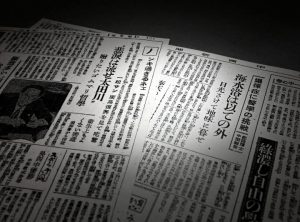Striving to fill voids in Hiroshima, Chugoku Shimbun and the press code — Surveillance of articles with A-bombing content, Part 2: Slow start to GHQ censorship
Sep. 21, 2023
In early phase, 71 Chugoku Shimbun articles with A-bombing content slipped through net of censorship
For regional newspapers such as the Chugoku Shimbun, the General Headquarters (GHQ) of the Allied Powers applied a “post-print censorship,” a style of controls placed on information that involved the checking of the pages of newspapers after publication. The system of post-print censorship was initiated gradually starting in the fall of 1945.
That censorship system was carried out by having Japan’s regional newspapers send two copies of its daily newspaper to a branch of the Civil Censorship Detachment (CCD), a department that fell under the auspices of the GHQ. Most of the CCD censors were Japanese. For articles deemed to require censorship, staff would translate the original Japanese article and submit the English version to an American supervisor. If the supervisor concluded that a certain article had violated the press code, the newspaper that published the information would be notified about the decision. If the violation was egregious, the CCD would summon a representative of the offending newspaper to one of its branches to provide a warning in person.
According to a review of the materials held at the University of Maryland’s Gordon W. Prange Collection, in which are archived Japanese publications censored during Japan’s occupation, it appears that the first application of post-print censorship on the Chugoku Shimbun took place on March 24, 1946.
Tokyo-based national newspapers were priority for censorship
National newspapers published in Tokyo underwent strict censorship starting in September 1945, soon after the occupation of Japan had begun. Because Tokyo-based media companies were considered to be a high priority, application of censorship on regional newspapers was delayed. In the fall of 1945, the GHQ began hiring Japanese censors who were proficient in English. The censors also were required to undergo training. For the above reasons, it took time to ramp up the censorship system across Japan.
To what extent were the Chugoku Shimbun’s articles with atomic-bombing content censored? If the GHQ were to have taken a strict stance on the issue, numerous articles would have been targeted for censorship. In the early stages of the program, however, that does not appear to have been the case.
The first article with A-bombing content thought to have been censored was published on June 3, 1946. By that time, two months had already passed since the censorship system was put in place. One article, titled “Mr. Ichimatsu, you were too optimistic: Surprised at lack of progress in Hiroshima’s recovery,” reported that Ishimatsu Ishida, a Hiroshima native who had been elected to serve as a member of the House of Representatives for the area, had returned to his hometown and visited the Chugoku Shimbun’s office. He was quoted as saying at the time, “I was surprised at the surprisingly slow pace of recovery.”
Meanwhile, during more than two months, from the end of April to early June 1946, 71 articles involving reports on the atomic bombing were published by the newspaper without being subject to censorship. Below are described some of the key articles falling under that category.
The articles included those titled “Battleship Nagato heads to Bikini Atoll,” which reported on the battleship that had departed Japan to join the A-bomb testing conducted by the United States on the Bikini Atoll in the Pacific Ocean (published on March 25, 1946); “U.S. House of Representatives passes a nuclear power control bill” (April 5, 1946); “Special benefits paid out to A-bomb victims” (May 11, 1946); “Medicine challenges A-bomb disease: Dr. Tsuzuki’s interim report” (May 22, 1946); and “Dr. Nishina holds lecture at Hiroshima Railway Bureau” (May 26, 1946).
Such articles contained details about the development of new atomic bombs, international controls on atomic weapons, and medical care and support for A-bomb survivors. They could have spread anti-American sentiment and information on the tragic nature of the atomic bombing to readers, but they happened to slip through the net of censorship.
Articles with scientific content
The irregular application of censorship at that time is symbolized by the failure to select articles with coverage on Masao Tsuzuki, a professor at the Faculty of Medicine at Tokyo Imperial University (present-day University of Tokyo), as well as those covering Dr. Yoshio Nishina, who headed the Institute of Physical and Chemical Research (Riken). Since the atomic bombings, those two individuals were at the forefront of providing medical treatment to A-bomb survivors and conducting research on the effects of the bombings.
In November 1945, at a meeting of a research council special task force at Japan’s Ministry of Education (present-day Ministry of Education, Culture, Sports, Science and Technology) for surveying A-bombing devastation, the GHQ declared that research into the atomic bombing constituted GHQ’s top-secret information and that publication of the research findings would not be permitted. Despite that, six months later, articles related to the studies conducted by the two scientists were published in newspapers.
Censorship was relatively mild at the start. What circumstances were behind that relatively relaxed oversight of published information?
(Originally published on September 21, 2023)








